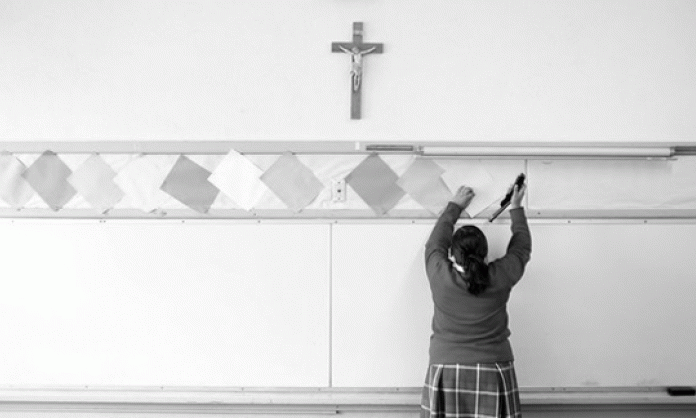I was a student at Catholic primary and secondary schools in Melbourne between 1956 and 1967 – a period when abuse was rife. While I did not personally experience or witness any sexual abuse at school, I did experience and witness extreme levels of physical abuse and humiliation.
This systematic physical violence is something that has been deliberately downplayed by the royal commission. The brutal violence directed against children was not something that could be dismissed as the actions of a minority of rogue priests. It was official and openly declared policy sanctioned by the church, the state and the media.
The official sanctioning of systematic physical violence is undoubtedly interconnected with the sexual abuse. It established the right of teachers and others in authority to mistreat and humiliate children.
Kids were caned, strapped, bashed with rulers or slapped for the most minor infringements of discipline or for not performing well in class.
Anything from not wearing your school cap on your way home, not having your tie done up properly, not doing all your homework, not paying sufficient attention or getting an answer to a question wrong could lead to a belting. Most of my high school teachers were Marist brothers and they could really dish it out, but some of the lay teachers, both male and female, were just as severe.
Most kids and their parents just accepted this degree of violence as the norm. Indeed, you were held in low esteem in your peer group if you were some teachers’ pet who was never belted.
Catholic schools were hardly some huge exception to the regular pattern in Australian capitalism at the time. Kids had next to no rights. Corporal punishment was still the go at state schools. Cops regularly belted you on the streets. Orphanages were hell holes. Parents had virtually an unfettered right to bash and bully their kids.
But in some ways the physical violence at school was not the worst abuse. The ritual humiliation, mockery and psychological torture were in many ways worse. In particular, kids whose parents had low status jobs, such as cleaners or garbos, were put down.
In primary schools, the nuns locked kids in cupboards and forced poorly performing students to wear dunces’ caps. Reflecting the entrenched sexism, the most demeaning punishment the nuns could impose on boys was to force them to dress as girls.
At high school most of us were much more intimidated by one of the brothers who hardly ever belted anyone but whose humiliating beratings and sarcastic put-downs cut deeper than any cane or strap.
Occasionally, there was a small rebellion. A student would refuse to hold out their hand to be caned or strapped.
The most dramatic and inspiring individual rebellion I witnessed was when a quite large boy grabbed the strap just as it was about to belt his hand and pulled the brother to the ground. The whole class just sat there dumbfounded. Unfortunately, because the student didn’t have broader, organised support, the authorities simply expelled him and we never saw him again.
There were at times more collective rebellions, particularly against lay teachers, who had less authority than the brothers and were less capable of controlling the huge classes of up to 60 boys. End of year break-ups could turn into near riots with students in their final year leading the charge, knowing that the headmaster had little come-back.





